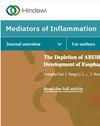Cell-Specific Regulation of Inflammatory Cytokines and Acute-Phase Proteins by the Glucocorticoid Receptor
IF 4.4
3区 医学
Q2 CELL BIOLOGY
引用次数: 1
Abstract
Background. Literature and data mining found abnormal induction of chemokine (C-X-C motif) ligand 1 (CXCL1) and CXCL8 and down-regulation of CXCL2 in inflammatory liver diseases. This study was performed to understand the glucocorticoid receptor’s (GR’s) effects on chemokine and acute-phase protein expression in human liver, in settings of bacterial infection (modeled using LPS) or inflammation (modeled using TNFα). Methods. Primary human hepatocytes (PHH) were treated with combinations of tumor necrosis factor alpha (TNFα), lipopolysaccharide (LPS), and dexamethasone (DEX) for 24 h, following which chemokine mRNA and protein expression were analyzed using qPCR and enzyme-linked immunosorbent assay assays. Dual luciferase assays were performed on transfected cell lines. Mutant CXCL2 promoters were used in dual luciferase assays to identify specific regions of the CXCL2 promoter affected by GR, TNFα, or hepatocyte nuclear factor 4α (HNF4α, a liver-enriched transcription factor). Results. In PHH from donor 1, GR strongly inhibited LPS-induced CXCL1 and CXCL8 translation and transcription, whereas CXCL2 transcription tended to increase with DEX treatment. In PHH from donor 2, DEX treatment inhibited protein expression and secretion of CXCL1 and CXCL8 induced by TNFα and/or LPS, whereas CXCL2 upregulation was largely unaffected by DEX treatment. In nonliver HEK293T cells GR activity inhibited CXCL2 promoter activity. However, in liver-derived HEPG2 cells, GR induced CXCL2 promoter activity. A 407-base pair region upstream of CXCL2 promoter is necessary for full GR functionality in HEPG2 cells. TNFα synergized with HNF4α in inducing CXCL2 promoter activity in HEPG2 cells. Conclusions. GR’s effects on chemokine expression are cell-type specific and chemokine specific. GR down-regulated CXCL1 and CXCL8 in different cell types, whereas the specific activation of CXCL2 in hepatocytes and down-regulation of CXCL2 in nonhepatocytes by GR appears due to cell-specific utilization of CXCL2 promoter. By specifically increasing GR activity in the liver, we may normalize chemokine imbalances and prevent sepsis in inflammatory liver diseases.糖皮质激素受体对炎症细胞因子和急性期蛋白的细胞特异性调节
背景。文献和数据挖掘发现,趋化因子(C-X-C基序)配体1 (CXCL1)和CXCL8在炎症性肝病中的异常诱导以及CXCL2的下调。本研究旨在了解糖皮质激素受体(GR)在细菌感染(用LPS模拟)或炎症(用TNFα模拟)环境下对人肝脏趋化因子和急性期蛋白表达的影响。方法。采用肿瘤坏死因子α (TNFα)、脂多糖(LPS)和地塞米松(DEX)联合治疗原代人肝细胞(PHH) 24 h,采用qPCR和酶联免疫吸附法分析趋化因子mRNA和蛋白的表达。对转染细胞系进行双荧光素酶测定。突变型CXCL2启动子用于双荧光素酶测定,以确定CXCL2启动子受GR、TNFα或肝细胞核因子4α (HNF4α,一种肝脏富集转录因子)影响的特定区域。结果。在供体1的PHH中,GR强烈抑制lps诱导的CXCL1和CXCL8的翻译和转录,而CXCL2的转录则随着DEX的处理而增加。在供体2的PHH中,DEX抑制了TNFα和/或LPS诱导的CXCL1和CXCL8的蛋白表达和分泌,而CXCL2的上调在很大程度上不受DEX的影响。在非肝脏HEK293T细胞中,GR活性抑制CXCL2启动子活性。然而,在肝源性HEPG2细胞中,GR诱导CXCL2启动子活性。在HEPG2细胞中,CXCL2启动子上游的一个407碱基对区域是完全GR功能所必需的。TNFα与HNF4α协同诱导HEPG2细胞CXCL2启动子活性。结论。GR对趋化因子表达的影响具有细胞类型特异性和趋化因子特异性。GR在不同细胞类型中下调CXCL1和CXCL8,而GR在肝细胞中特异性激活CXCL2和在非肝细胞中下调CXCL2是由于细胞特异性利用CXCL2启动子。通过特异性地增加肝脏中的GR活性,我们可以使趋化因子失衡正常化,并预防炎症性肝病中的败血症。
本文章由计算机程序翻译,如有差异,请以英文原文为准。
求助全文
约1分钟内获得全文
求助全文
来源期刊

Mediators of Inflammation
医学-免疫学
CiteScore
8.70
自引率
0.00%
发文量
202
审稿时长
4 months
期刊介绍:
Mediators of Inflammation is a peer-reviewed, Open Access journal that publishes original research and review articles on all types of inflammatory mediators, including cytokines, histamine, bradykinin, prostaglandins, leukotrienes, PAF, biological response modifiers and the family of cell adhesion-promoting molecules.
 求助内容:
求助内容: 应助结果提醒方式:
应助结果提醒方式:


